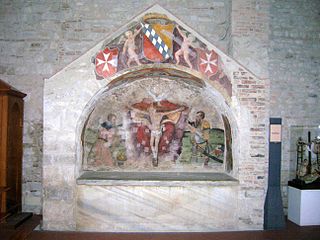
This page is a list of the rulers of the Principality of Salerno .

The Lombard Principality of Salerno was a South Italian state, formed in 851 out of the Principality of Benevento after a decade-long civil war.
Contents
When Prince Sicard of Benevento was assassinated by Radelchis in 839, the people of Salerno promptly proclaimed his brother, Siconulf, prince. War raged between Radelchis and Siconulf until Emperor Louis II came down and forced a peace in 851, confirming Siconulf as prince of Salerno. The chronology is very confusing from then on until the assassination of Adhemar, when a new dynasty took the throne.

Sicard was the Prince of Benevento from 832. He was the last prince of a united Benevento which covered most of the Mezzogiorno. On his death, the principality descended into civil war which split it permanently. He was the son and successor of the Spoletan Sico.
Radelchis I was the treasurer, then prince of Benevento from 839, when he assumed the throne upon the assassination of Sicard and imprisonment of Sicard's brother, Siconulf, to his death, though in his time the principality was divided.
Adhemar was the son of Prince Peter of Salerno. He succeeded his father, an usurper, in 853.
Salerno was besieged by the Normans of Robert Guiscard and Prince Richard I of Capua until it fell on 13 December 1076. Prince Gisulf II surrendered the next year and the principality, the final Lombard state in Italy, fell. Salerno became the capital of Guiscard's duchy of Apulia, Calabria, and Sicily.

The Normans are an ethnic group that arose in Normandy, a northern region of France, from contact between indigenous Franks and Gallo-Romans, and Norse Viking settlers. The settlements followed a series of raids on the French coast from Denmark, Norway, and Iceland, and they gained political legitimacy when the Viking leader Rollo agreed to swear fealty to King Charles III of West Francia. The distinct cultural and ethnic identity of the Normans emerged initially in the first half of the 10th century, and it continued to evolve over the succeeding centuries.

Robert Guiscard was a Norman adventurer remembered for the conquest of southern Italy and Sicily. Robert was born into the Hauteville family in Normandy, went on to become Count of Apulia and Calabria (1057–1059), and then Duke of Apulia and Calabria and Duke of Sicily (1059–1085), and briefly Prince of Benevento (1078–1081) before returning the title to the Pope.
Richard Drengot was the count of Aversa (1049–1078), prince of Capua and duke of Gaeta (1064–1078).
"Prince of Salerno" was also a title created by Charles I of Naples (reigned 1266-1285) for his son, later Charles II of Naples. It was regularly used for the heirs of the Kings of Naples and later the Two Sicilies. In the fourteenth century, most of the province of Salerno became the territory of the Princes of Sanseverino.

Charles II, also known as Charles the Lame, was King of Naples, Count of Provence and Forcalquier (1285–1309), Prince of Achaea (1285–1289), and Count of Anjou and Maine (1285–1290); he also styled himself King of Albania and claimed the Kingdom of Jerusalem from 1285. He was the son of Charles I of Anjou—one of the most powerful European monarchs in the second half of the 13th century—and Beatrice of Provence. His father granted Charles the Principality of Salerno in the Kingdom of Sicily in 1272 and made him regent in Provence and Forcalquier in 1279.





